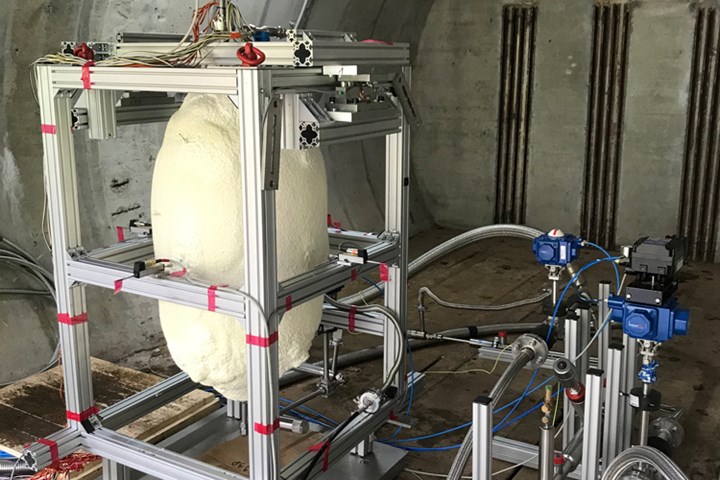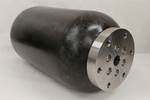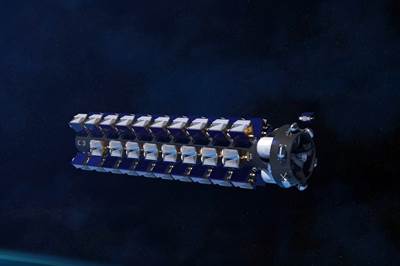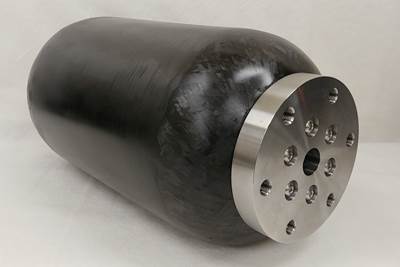MT Aerospace proves out CFRP hydrogen tank for rocket propulsion
Comprehensive test campaign under the ESA’s ComET project proves linerless composite pressure tank prototype can withstand cryogenic stresses inherent to rocket flight.

Prototype CFRP tank. Photo Credit: MT Aerospace AG
MT Aerospace AG (Augsburg, Germany), a subsidiary of space and technology group OHB SE (Bremen), has reached an important milestone in the targeted development of a carbon fiber-reinforced polymer (CFRP) upper stage for a future European launcher. A prototype of the high-performance CFRP tank targeted for rocket engines was tested at the DLR German Aerospace test center facility in Trauen, Germany, as part of the European Space Agency’s (ESA) ComET project within the Future Launchers Preparatory Programme (FLPP).
MT Aerospace says the CFRP tank has proven its structural load-bearing capacity and tightness over several pressure cycles at cryogenic temperatures around 20 Kelvin (-253°C), despite the fact that it is linerless. “The test result is a groundbreaking success in Europe; after all, fuel tanks are safety-critical elements in any propulsion system,” explains Hans Steininger, CEO of MT Aerospace AG. “We have provided proof that a high-performance pressure tank made of CFRP can withstand cryogenic stress. In the future, the use of CFRP high-performance tanks should not only enable safe rocket launches, it can also exploit the advantage of significantly lower mass compared to metallic tanks.”
The test campaign was carried out in several stages, as hydrogen has to be specially treated and stored; according to the company, hydrogen only assumes a liquid state at 20 K (-253.15°C, -423.67°F). The test specimen, a tank with a diameter of 400 millimeters, was first subjected to a helium leak test at room temperature and at about 77 Kelvin (-196.15°C, -321.07°F). It was then filled with liquid (i.e., cryogenic hydrogen (LH2)). After filling, the tank was pressurized beyond the supercritical LH2 pressure in order to achieve a stress condition that is to be expected when used in a rocket flight. Consequently, MT Aerospace was able to successfully demonstrate that the CFRP tank it developed and manufactured meets the specified requirements in terms of LH2 tightness along the entire load history, even when exposed to a combination of cryogenic thermal loads and simultaneous, high mechanical loads. Further filling and emptying cycles also underlined the excellent behavior of the tank.
To confirm the tank’s quality, an additional helium leakage test was completed. This gave MT Aerospace the go-ahead for another test, which will focus on the tank’s reaction when filled with liquid oxygen (LOX) under cryogenic conditions. This second test campaign is intended to prove that the CFRP material selected is suitable for use with both media (i.e., liquid hydrogen and liquid oxygen) in a future upper stage.
For MT Aerospace, the test result forms a solid foundation for the upcoming material decisions within the framework of the PHOEBUS upper stage demonstrator project, with which ArianeGroup (Bremen, Germany) was recently commissioned. The project aims to define, manufacture and test tanks with a diameter of two meters by the end of 2022, in preparation for near full-scale structural upper stage demonstrator.
“The test results are very encouraging for us, especially in view of our recent investment to expand the company's CFRP manufacturing environment,” adds Dirk Lanuschny, head of Launcher Programmes at MT Aerospace AG, referring to an automated fiber placement (AFP) facility that will enable the production of tanks with diameters typical of launch vehicles in early 2022. “As part of the PHOEBUS project, we intend to manufacture the two cryogenic tanks [LH2, LOx] as well as the primary structures of an upper stage demonstrator with a diameter of 3.5 meters.”
Related Content
ASCEND program update: Designing next-gen, high-rate auto and aerospace composites
GKN Aerospace, McLaren Automotive and U.K.-based partners share goals and progress aiming at high-rate, Industry 4.0-enabled, sustainable materials and processes.
Read MoreWelding is not bonding
Discussion of the issues in our understanding of thermoplastic composite welded structures and certification of the latest materials and welding technologies for future airframes.
Read MorePlant tour: Joby Aviation, Marina, Calif., U.S.
As the advanced air mobility market begins to take shape, market leader Joby Aviation works to industrialize composites manufacturing for its first-generation, composites-intensive, all-electric air taxi.
Read MorePlant tour: Middle River Aerostructure Systems, Baltimore, Md., U.S.
The historic Martin Aircraft factory is advancing digitized automation for more sustainable production of composite aerostructures.
Read MoreRead Next
FACC develops and manufactures composite structures for Ariane 6 launch vehicle
Astris kick stage main structure will be characterized by high strength and the use of ultralight carbon fiber material, with first delivery scheduled for October 2022.
Read MoreLockheed Martin Australia and Omni Tanker develop new composite tanks for cryogenic fuels
Partnership aims to commercialize Type IV and V tanks using patented OmniBIND technology for Lockheed Martin and NASA applications.
Read More“Structured air” TPS safeguards composite structures
Powered by an 85% air/15% pure polyimide aerogel, Blueshift’s novel material system protects structures during transient thermal events from -200°C to beyond 2400°C for rockets, battery boxes and more.
Read More













.jpg;maxWidth=300;quality=90)












